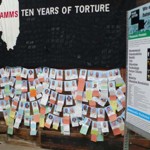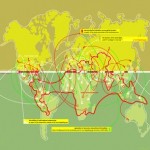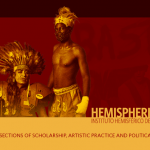“Living as Form” and the Hemispheric Institute: Two approaches to art and politics
Creative Time Summits (here is the schedule of the upcoming Summit) are a primary place for the discussion of socially engaged artistic practices. Laurie Jo Reynolds (above) is one artist who has been featured several times for her important work, moving from an artist working with prisoners at Tamms Supermax Prison, to a political activist for prison reform.
Throughout Living as Form, edited by Nato Thompson, a book based largely on last year’s Creative Time Summit, artists who take on political and social issues in the public sphere, are celebrated. But the (exciting) transitions currently emerging in the critical discussion of this formerly discredited practice are evident. There is a pervading anxiety about and sometimes dismissal of concepts such as ‘relational aesthetics’, ‘social aesthetics’, ‘social practice’, ‘tactical media’, ‘dialogic art’, and ‘new genre public art’. Since the 1990s these terms have been the standard vocabulary for analysing public practice art.
This anxiety reminds us that, in fact, immediately after this book was published, in the fall of 2011, and even as the Forum it was based on was taking place, the Occupy movement in Wall Street and the City of London as well as elsewhere around the world, burst through traditional patterns of protest. It had complex roots in various ideologies, including anarchism, Socialism, pacifism, anti-capitalism, and many others. In New York there was a direct connection to resistance in Greece and Spain. It became a worldwide embodiment of living as protest. As both an aesthetic and political statement in public space, it has forced a new and multifaceted analysis of the constantly changing relationship of art and politics, particularly in the public sphere.
Nato Thompson, as chief curator at Creative Time, presciently adopted what he calls the ‘cattle call’ method in his introduction, which includes projects initiated by both artists and non-artists. He suggests that non-profit organizations themselves can be ‘artworks’. This idea is both provocative and timely. Unfortunately, the cattle call also extends to his enumeration of political and social crises, which he lumps into a single paragraph, as well as to the all-too-brief discussions of artists and projects.
One critic who interviewed Thompson on his thesis that NGOS, street protest and performance art are all equal was Barbara Pollack
Other authors in the book, and participants in the forum include theorist Clare Bishop, who sets up a relationship between the ‘social discourse’ and the ‘artistic discourse’ that can be ‘unseated’ by participatory art works. Maria Lind, a curator, emphasizes projects that include people in social and political change, while Carol Becker offers ‘microtopia’ or small solutions to big problems. Brian Holmes, a philosopher involved with the international social justice movement, and Shannon Jackson, director of the Arts Research Center at University of California, Berkeley, emphasize the 1930s Federal Theater Project as a precedent for political art in the community.
By far the most radical essay, though, is by Teddy Cruz, trained in architecture and design, and a dynamic thinker who up-ends these issues by placing the real world at the forefront. He begins with an eloquent critique of our current state: ‘a critical juncture in history, defined by unprecedented socio-economic, political and environmental crises across any imaginable register’. For him, ‘our institutions… have atrophied’. His refreshing analysis of the relationship of art and economics concludes with the idea that marginal communities of immigrants are the real sites of creative thinking.
The rest of the book is an alphabetical listing of just over 100 artists, groups, and projects in public spaces that engage with a range of issues. The book is a valuable point of departure for its subject, although the elite cultural position of the authors limits its scope. Certain topics are popular here (those relating to urban renewal or alternative economics, for example), and other areas are barely covered, such as immigration (there is no reference to the border art of the last 50 years).
Equally exciting is Diana Taylor of the Hemispheric Institute of Performance and Politics (stunning website!) “working at the intersections of scholarship, artistic practice and political life in the Americas.” The Hemispheric Institute has an a Digital Video Library with 600 videos on line of socially engaged performance art in the Americas over the last thirty years. As Diana Taylor put it, “As long as human beings can make room for imagination, they can be artists.”
She askes “how do resistance strategies travel?
The Institute is also “a network of interdisciplinary and multilingual artists academics, and activists in the Americas. It creates collaborations that explore emboddied practice -performance -as a means for the creation of new meanings and the transmission of cultural values, memory and identity.” It operates in multiple countries and languages.
One of its current activities is to provide space for the Yes Lab, an opportunity for the Yes Men to interact with Occupy activists to create effective interventions in the political and public arena.
Diana Taylor agrees with the idea that embodied public poltiical activism is equallysignficant as self designated artists who create public art works. She is also erasing any distinction between art and activism, between the world and aesthetics.
Creative Time and the Hemispheric Institute are only a few blocks apart in NYC. Perhaps they have spoken with each other. I hope so.
This entry was posted on September 15, 2012 and is filed under #Occupy movement, Art and Activism, Art and Politics Now.











